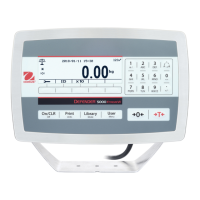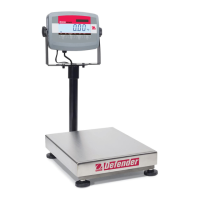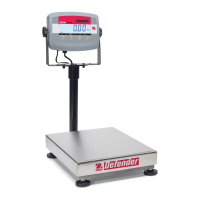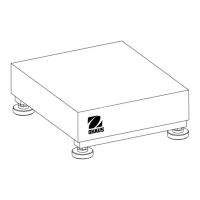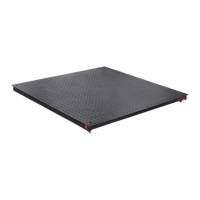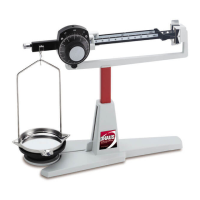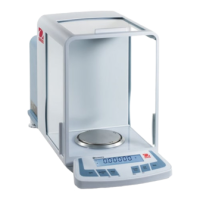What is EEP Error on OHAUS Defender 5000?
- VVanessa RiceSep 6, 2025
The EEP Error on OHAUS Accessories indicates a corrupted EEPROM data.
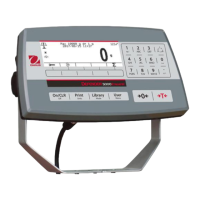
What is EEP Error on OHAUS Defender 5000?
The EEP Error on OHAUS Accessories indicates a corrupted EEPROM data.
What does NO.SW mean on my OHAUS Defender 5000?
If your OHAUS Accessories displays ‘NO.SW’, it means you are attempting to exit the menu with the LFT setting ON and the security switch OFF. Set the security switch to the ON position.
What does REF WT Err mean on my OHAUS Defender 5000?
If your OHAUS Accessories displays ‘REF WT Err’, the reference weight is too small. Use a greater weight for the sample.
What to do if my OHAUS Defender 5000 unit will not turn on?
If the OHAUS Accessories unit does not turn on, first check the power cord connections to ensure it is properly plugged into both the unit and a functioning power outlet. Verify the power source is supplying electricity. If using a T52P model, the batteries may be discharged and need replacement. If these steps don't resolve the issue, service is required.
What does it mean when the battery symbol is flashing on my OHAUS Defender 5000 Accessories?
If the battery symbol is flashing on your OHAUS Accessories (T52P), it indicates that the batteries are discharged and need to be replaced.
How to change menu settings on my OHAUS Defender 5000 Accessories?
If you cannot change menu settings on your OHAUS Accessories, it is likely that the menu has been locked. To unlock it, set the selected menu to Off in the Lock Menu. Additionally, the Lockout Switch on the circuit board may need to be set to the Off position.
How to display weight in the desired weighing unit on my OHAUS Defender 5000?
If your OHAUS Accessories cannot display weight in the desired weighing unit, the unit may not be set to On in the Units Menu. Enable the unit in the Units Menu.
What to do if my OHAUS Accessories scale cannot zero?
If the OHAUS Accessories scale cannot zero, or will not zero when turned on, it may be due to the load on the scale exceeding allowable limits, the load not being stable, or load cell damage. Remove the load from the scale and wait for it to become stable. If the problem persists, service is required.
Why am I unable to calibrate my OHAUS Defender 5000 Accessories?
If you are unable to calibrate your OHAUS Accessories, it might be because the Lock Calibration Menu is set to On, or the LFT menu is set to On, or you are using an incorrect value for the calibration mass. Set the Lock Calibration Menu to Off and the LFT menu to Off. Ensure you are using the correct calibration mass.
What to do if my OHAUS Defender 5000 shows Error 9.5?
If the OHAUS Accessories scale displays Error 9.5, it indicates that calibration data is not present. You should calibrate the scale.
| Brand | OHAUS |
|---|---|
| Model | Defender 5000 Series |
| Category | Accessories |
| Language | English |
General safety guidelines for safe and dependable operation of the equipment.
Lists the items to be unpacked for the TD52P or TD52XW indicator.
Describes how to connect external components like the scale base, RS232 cable, and power.
Instructions for opening the housing and making internal connections.
Instructions for installing an SD card for additional storage in the indicator.
Explains how to reverse the rear housing for different connection exit orientations.
Instructions for attaching the mounting bracket to a wall or table.
Overview of the indicator's menu system, categorizing settings into Calibration, Setup, Read Out, and Application Mode.
Guides users on how to navigate through the indicator's menus using softkeys.
Introduces the three calibration methods available on the indicator.
Details the procedure for performing zero calibration on the indicator.
Explains the process of span calibration using a calibration mass.
Configuration of units, capacity, graduation, language, and power-on settings.
How to select the unit of measure for calibration.
Setting the number of weighing intervals and graduations for single or dual interval use.
Customizing display functionality like stability, zero range, and brightness.
Adjusting the reading variation before the stability symbol turns off.
Setting the percentage of scale capacity that can be zeroed.
Activating desired units of measure for weighing.
Setting up Good Laboratory/Manufacturing Practice data like date and time.
Configuring external communication methods and printing parameters.
Configuration settings for RS232 communication, including parameters and print setup.
Options for configuring print output and templates for RS232 communication.
Configuring access to lock certain keys on the indicator.
Using the application to determine the weight of items.
Customizing user preferences for the Weighing application.
Using the application to count samples of uniform weight.
Setting the Average Piece Weight (APW) for counting operations.
Comparing weight or pieces against target limits.
Performing check weighing and defining over/under limits.
Measuring sample weight as a percentage of a reference weight.
Methods for establishing a reference weight for percent weighing.
Weighing unstable loads like moving animals.
Customizing user preferences for the Dynamic Weighing application.
Selecting between countdown or continuous mode for dynamic weighing.
Choosing between Manual, Semi-Automatic, or Automatic start/stop for dynamic weighing.
Setting the averaging time for dynamic weighing.
Using the application to fill a container to a predetermined target weight.
Setting up four target weights (SP1-SP4) for the filling application.
Lists OHAUS and MT-SICS commands for controlling the indicator via serial interface.
Pin connections for the RS232 serial port.
Instructions for connecting the indicator to a computer via serial cable.
Details on printout formats for weighing applications.
Managing libraries for Weighing, Counting, Check, and Filling applications.
Searching for items within the indicator's library.
Recalling items from the library.
Procedure for logging into the indicator with user credentials.
Information on storing and managing user profiles on the SD card.
Editing or deleting user accounts, with role-based permissions.
Displaying individual Alibi records including ID, weight, and time.
Steps to configure settings before verification and sealing.
Information about the verification procedure by authorized agents.
Cleaning instructions for the T52P indicator housing and control panel.
Cleaning instructions for the TD52XW indicator housing and control panel.
A table of common symptoms, causes, and remedies for indicator issues.
Detailed technical specifications including materials, ambient conditions, and power.
List of available accessories and optional kits for the indicator.
Visual representations and measurements of the TD52P and TD52XW models.
A table providing GEO codes based on latitude and elevation for calibration.
Details on MT Standard Continuous Output format and status byte definitions.
A list of MT-SICS commands for controlling the indicator.
